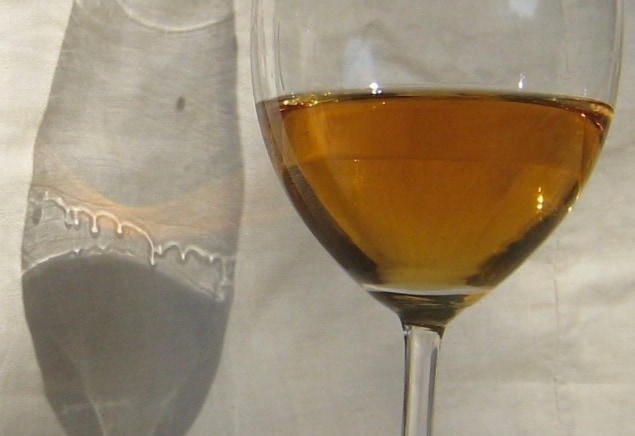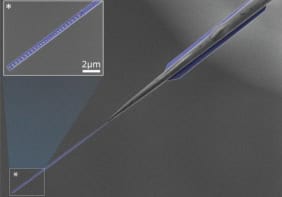
The role of gravity in producing distinctive dribbles of wine called tears has been explained by scientists in the US. Andrea Bertozzi and colleagues at the University of California, Los Angeles have shown the forces on a film of wine on the side of a glass create a “reverse undercompressive shock wave” that breaks up to form tears
Tears – sometimes called legs or fingers – are best observed in higher alcohol wines at room temperature. Using a martini glass with a fixed wall angle also helps. To create tears, begin by covering the glass and swirling the wine. Then set down the glass and remove the cover after a few seconds. You should see a circular wave sloshing around the glass that climbs up above the meniscus. As it travels, the wave creates small droplets that fall back into the glass in shape reminiscent of human tears that endure for much longer than the wave.
For more than a century, physicists have known that wine climbs the side of a glass in a process called Marangoni flow. In 1855, James Thompson (brother to Lord Kelvin) was the first to describe the effect. Ten years later the Italian physicist Carlo Marangoni wrote about the flow in a dissertation – and ultimately lent his name. Then in 1878, the American polymath Willard Gibbs published a theory describing Marangoni flow.
Marangoni flow occurs at the interface of two liquids with different surface tensions. With tears, the difference is created by the rapid evaporation of alcohol from a film of wine clinging to the inner surface of the glass above the fill line. The loss of alcohol increases the surface tension of the remaining liquid in the film relative to the wine in the glass below. This pulls liquid up from the glass, which eventually falls back down in dribbles called tears, legs or fingers. What had puzzled researchers, is why the liquid forms tears, rather than flowing back down in a sheet or stream.
Upgraded class project
Although Marangoni flows have been studied for 165 years, the underlying theory was not complete. In 2019 Andrea Bertozzi was preparing a lecture on tears of wine and told Physics World: “I thought that I would do a fun lecture and I could even bring some wine to do a demonstration. As I was preparing my materials and going through the research papers in detail, I realized that there was a big gap in the literature”.
She adds, “Part of my lecture ended up being about what was missing and what we could do about it scientifically. My student Yonatan Dukler decided to make this topic his class project”. That project has now been extended and the results published in Physical Review Fluids with Dukler as the lead author and Hangjie Ji and Claudia Falcon lending a hand.
Reverse undercompressive shock
The four researchers realized that the current theory of tear formation did not do a very good job at describing the role of gravity, which pulls the liquid down the side of the glass in the form of tears. The team created a quantitative model that assumed a constant surface tension gradient up the side of the glass. They discovered that the thickness of the liquid film climbing up the glass plays a crucial role in the formation of tears.

Six secrets of champagne
If the liquid crept up the glass in a uniform thick film it would simple stream back down again, rather than creating tears. Instead, experiments and calculations done by Bertozzi and colleagues show that the liquid moves up in a bulge-like wave that leaves a thinner film behind it. This can be described as a “reverse undercompressive shock wave”, which is known to be unstable. This means that small inhomogeneities along the wave can cause it to break up into tears.
According to Omar Matar of Imperial College London, the research is “a significant result that illustrates the richness in physics and underlying mathematical structure of the tears of wine problem, which continues to be a source of fascination to scientists in the present day”. He adds that the work, “represents a departure point to a number of exciting future directions that allow us to explore such factors as the influence of the three-dimensional geometry of the glass, and the development of surface tension gradients up the glass, on the morphology of the tears”.



